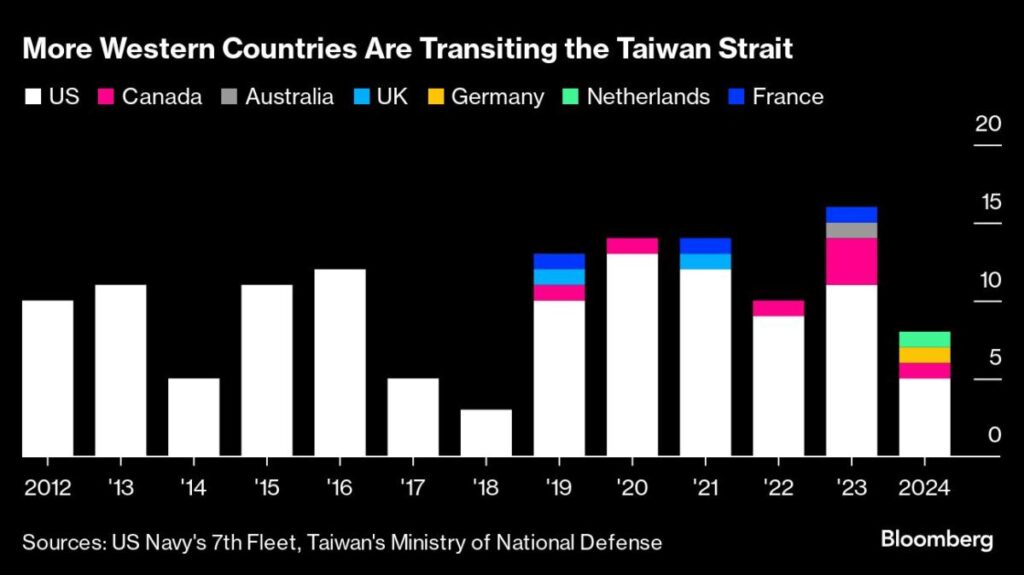(Bloomberg) — Germany sent its first warship through the Taiwan Strait in 22 years, ignoring warnings from China as ties between the two sides have been strained by trade and Russia’s war in Ukraine.
Most read from Bloomberg
The Baden-Württemberg and a support ship sailed through the strait on Friday, German Defense Minister Boris Pistorius said at a news conference in Berlin. “International waters are international waters. It is the shortest and, given the weather conditions, also the safest route. So we are going through,” he said.
Berlin’s rare trip could anger Beijing, which has been ramping up military, economic and diplomatic pressure on President Lai Ching-te, who refuses to back down from claiming his democratically governed island is part of China. Beijing has not ruled out taking the territory by force.
Chinese Foreign Ministry spokeswoman Mao Ning earlier this month called any passage an “act of provocation under the pretext of freedom of navigation,” when asked about Berlin’s plans. Such actions “harm China’s sovereignty and security,” she added.
The German move underscores the growing willingness of U.S. allies to defy President Xi Jinping and send ships through one of the world’s busiest shipping lanes. China does not claim sovereignty over the strait but seeks to regulate the waterway and objects to transit by foreign powers.
European Union countries have expanded their presence in the Indo-Pacific region this year, according to Hsu Chih-hsiang, assistant analyst at Taiwan’s Institute for National Defense and Security Research.
“EU countries are unlikely to send ships or troops if China invades Taiwan,” he said. “But they can still send warships in peacetime to show their concerns.”
Germany considered sending a frigate through the Taiwan Strait several years ago, but canceled the plan because then-German Chancellor Angela Merkel did not want to irritate China, he added. The US regularly conducts transits through the strait, and France, the UK and Canada have all sent ships in recent years.
The Chinese military has become more assertive toward Taipei, sending a record swarm of fighter jets across a U.S.-drawn border in the Taiwan Strait earlier this year. That comes as Beijing increasingly clashes with U.S. ally the Philippines in the nearby South China Sea, where Xi also has territorial claims.
Pistorius earlier this year raised the alarm about China’s growing military ambitions in the Indo-Pacific. “There is growing fear about Beijing’s military buildup,” he said, citing “its aggressive economic policies and its open quest for geopolitical dominance.”
Berlin is trying to balance those security concerns with its important economic relationship with China. Chancellor Olaf Scholz joined Spanish Prime Minister Pedro Sanchez this week in calling on the EU to reconsider tariffs on Chinese-made electric cars, amid concerns the move could backfire on their domestic industries.
Relations between Berlin and Beijing have cooled under Scholz, who has criticized the world’s second-largest economy for flooding its market with cheap goods. The Chinese leader’s support for Russia despite the war in Ukraine has become another sore point in bilateral ties.
The chairman of the German parliament’s foreign affairs committee, Michael Roth, defended his country’s actions earlier this month. “A transit is not a provocation,” he wrote on X. “We stand for peace and security in the Taiwan Strait and oppose any unilateral and violent change of the status quo by China.”
According to Lin Po-Chou, an assistant researcher at the Institute for National Defense and Security Research in Taipei, Germany’s latest move was likely intended to warn China against military adventure.
“It is becoming increasingly important for Western countries to deter China’s possible invasion of Taiwan in peacetime,” he said.
–With assistance from Jing Li and Iain Rogers.
Most read from Bloomberg Businessweek
©2024 Bloomberg LP

